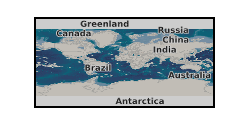1975
Type of resources
Available actions
Topics
Keywords
Contact for the resource
Provided by
Years
Formats
Representation types
Update frequencies
Scale
Resolution
-

Earthquake catalogue of all known UK events greater than magnitude 4 ML, and greater than 3 ML, post 1700. The catalogue covers the offshore areas as well as mainland UK, covering an area between 10 degrees West to 4 degrees East and 49 degrees to 62 degrees North. This includes all of Ireland and some earthquakes in northern France that were also felt in the UK. Earthquakes outside this area are also included if they were felt in the UK.
-

This dataset contains parametric data (epicentre, magnitude, depth, etc) for over one million earthquakes worldwide. The dataset has been compiled gradually over a period of thirty years from original third-party catalogues, and parameters have not been revised by BGS, although erroneous entries have been flagged where found. The dataset is kept in two versions: the complete "master" version, in which all entries for any single earthquake from contributing catalogue are preserved, and the "pruned" version, in which each earthquake is represented by a single entry, selected from the contributing sources according to a hierarchy of preferences. The pruned version, which is intended to be free from duplicate entries for the same event, provides a starting point for studies of seismicity and seismic hazard anywhere in the world.
-
The Land Classification of Cumbria is a classification of the county of Cumbria (Great Britain) into a set of 16 environmental strata, termed land classes, to be used as a basis for ecological survey, originally developed by the Institute of Terrestrial Ecology (ITE) in 1975. The strata were created from the multivariate analysis of 150 environmental variables, including topographic data, geographical features and geology data. The Land Classification can be used to stratify a wide range of ecological and biogeographical surveys to improve the efficiency of collection, analysis and presentation of information derived from a sample. Full details about this dataset can be found at https://doi.org/10.5285/0ac6249c-a6f2-4147-8ae9-50d576e85fc5
-
This dataset comprises plant species, soils, habitat types and major biota present, collected during a survey of the English county of Cumbria, using standardised survey methods. The survey was undertaken by the Institute of Terrestrial Ecology (a forerunner of the Centre for Ecology & Hydrology) in 1975 within a stratified random set of sites. In total, up to 650 plots were surveyed from within 48 x 1km squares. Full details about this dataset can be found at https://doi.org/10.5285/e96b909d-d52e-4b36-bc51-905ece420794
-

Results of geotechnical testing carried out, at various depth intervals, on shallow cores or boreholes collected by BGS from the UK Continental Shelf (UKCS). The bulk of the data north of 56N are in digital form and result from testing carried out onboard survey vessels using hand-held test equipment (penetrometers and shear vanes). These values are averaged for each test interval, and are expressed in kilopascals (kPa). There are approximately 6,000 test results in the dataset. Some more detailed test information, in non-digital and report form, is held for selected sites. For most sites where digital data are not available, geological descriptions of core material contain semi-quantitative information on the stiffness of the material. Geotechnical knowledge is required to understand and interpret the results if they are to be used as a basis for engineering studies. Core material is managed as part of the BGS materials collection and is available for examination, testing or subsampling. The data are stored as part of the National Geoscience Data Centre (NGDC) and the Marine Environmental Data and Information Network (MEDIN) Data Archive Centre (DAC) for geology and geophysics. Data are delivered via the 'Offshore samples: geotechnical data' layer on the BGS GeoIndex. Reference: Fannin, NGT. (1989) Offshore Investigations 1966-87. British Geological Survey Technical Report WB/89/2, British Geological Survey.
-

The concentrations of up to 30 trace elements in approximately 9,000 sea-bed samples from the UK Continental Shelf were determined by BGS using a variety of analytical techniques. In some cases samples were tested using more than one method. The analyses were carried out on freeze-dried samples of the sand and mud fractions of the samples. The data are stored as part of the National Geoscience Data Centre (NGDC) and the Marine Environmental Data and Information Network (MEDIN) Data Archive Centre (DAC) for Geology and Geophysics. Data are delivered via the BGS Offshore GeoIndex www.bgs.ac.uk/GeoIndex/offshore.htm geochemical layers. References: Stevenson, A G (2001) Metal concentrations in marine sediments around Scotland: a baseline for environmental studies, Elsevier Science; Stevenson, A G et al (1995) The geochemistry of sea-bed sediments of the United Kingdom Continental Shelf : the North Sea, Hebrides and West Shetland shelves, and the Malin-Hebrides sea area (http://nora.nerc.ac.uk/507899/).
-

A collection of 1:250 000 scale geophysical maps in the Universal Transverse Mercator (UTM) projection, covering the United Kingdom and continental shelf areas between 1975 – 1990. Mapping is divided into squares which cover 1 degree by 1 degree of latitude / longitude. A geophysical map is a graphical representation of data collected through various geophysical methods to investigate the subsurface characteristics of the Earth. Geophysics is the study of the physical properties and processes of the Earth using measurements of physical quantities such as gravity, magnetic fields, seismic waves, electrical resistivity, and others. The collection includes aeromagnetic anomaly maps (1975 – 1990), Bouguer gravity anomaly maps (1975 – 1989) and a small number of free air anomaly maps (1981 – 1989). These maps are hard-copy paper records stored in the National Geoscience Data Centre (NGDC) and are delivered as digital scans through the BGS website.
 NERC Data Catalogue Service
NERC Data Catalogue Service